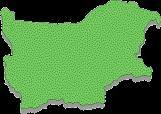|
|
Montana region comprises the north west part of Bulgaria. The area is 10,607 sq. km (9.6% of the territory of the country). The northern boundary, the Danube, has an impact on the whole social-economic development of the region.
Communications with the Republic of Serbia are at the West border between Bregovo and Negotin and between Kula and Zajcar. The shortest distance between Danube and the Aegean Sea is the line
Lom-Sofia-Blagoevgrad-Kulata- Thesaloniki. A high speed railway is to built on it. The social-economic development of the region depends mostly on the passes along the Iskar river gorge, Petrohan and Vrashka Chuka. A free trade zone has been established in Vidin.
The deposits of iron ores (Chiprovtsy), and polymetal ores (Chiprovtsy and Vratsa) are limited. The climate is temperate continental. The flatland part of the region (60% of the area) together with the fertile soils provides excellent conditions for the development of agriculture. Still the water resources are underused. The water at Varshets can cure.
Montana region is with the smallest population - 626,205 (7.4% of the population in the country). Due to different reasons it is decreasing. The urban-rural population ratio town is 57:43. The vital statistics of the region is
alarming. The age structure is bad and the natural growth is negative.
The economic structure of the region is industrial-agrarian. The regional employment accounts for 6.9% of the national employment. Electricity production is a priority. The only nuclear power plant on the Balkans, generating 38% of Bulgarian electricity is at Kozloduy at the Danube. Operation is under strict control. The country's limited sources of electricity necessitate the development of nuclear power production. Food industry with basic
centers Vidin (canning), Montana (canning and meat) and Vratsa (meat) will become increasingly important for the region economy. Textile industry as a tradition in Vratsa (cotton fabrics) and Chiprovtsy (brand carpets).
Conditions for the development of agriculture are good. The per capita produce is greater (in value and in kind) than the average for the country. The enterprise mix in 1993 was: 60% cereals, 17% industrial crops, 3% vegetables and 20% fodder crops. The region produces 8% of the wheat, 6% of the sunflower, 3% of the maize in the country. Land restitution leads to a new type of cooperative farms. There is a sharp increase of farm production from the private sector (45%).
The administrative center of the region is Montana (population 60,000) is an important transport junction. Vratsa and Vidin are towns with regional functions.
They are famous with their beauty caves Ledenika and Magurata in the proximity are visited by many tourists. The Belogradchik Rocks are queer workings of nature near Belogradchik. Baba Vida is a museum castle in
Vidin.
|
